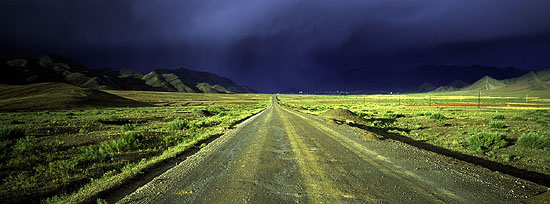

Shankara’s Philosophy of Non-Dualism----Advaita
"Brahman----the absolute existence, knowledge and bliss---- is real. The universe is not real. Brahman and Atman (man’s inner Self) are one" That means Brahman and the true Self (atman) are real.
Shankara’s reality is that which never changes nor ceases to exist. According to the Upanishads, no object, no knowledge can be absolutely real if its existence is only temporary. Absolute reality implies permanent existence. Every object of knowledge, external or internal is subject to modification and therefore, by Shankara’s definition “not real”.
What, then, is the Reality behind all our experiences? There is only one thing that never leaves us---our deep consciousness. This alone is the constant feature of all experience. This consciousness is the real, absolute Self. In dreamless sleep, also the real Self is present as a witness, while the ego, our individuality has become temporarily merged in ignorance and disappeared in deep sleep. That means in deep sleep, there are no thoughts, no events, no individuals and no memories. It also means that the individual when awakened cannot remember that its ego was submerged in its true Self.
The world “is and is not”. Its fundamental unreality can only be understood in reference to the ultimate mystical experience, the experience of an illumined soul. When the illumined soul passes into transcendental consciousness, he realized the Self (atman) as pure bliss and pure intelligence, the “one without a second”. In this state of consciousness all perception of multiplicity ceases, there is no longer any sense of “mine” and “thine”. The world as we ordinarily know it has vanished. The Self shines forth as the One, the Truth, the Brahman, and the basis of this world-appearance. World-appearance as it is experienced in the waking state may be likened, says Shankara, to an imagined snake, which proves, on closer inspection, to be nothing but a coil of rope. When the truth is known, we are no longer deluded by the appearance----the snake-appearance vanishes into the reality of the rope, the world vanishes into Brahman.
Other systems of Hindu philosophy---Sankya, Yoga or Nyaya---maintain that the phenomenal world possesses an objective reality, even though it may not be apparent to the eyes of an illumined soul. Advaita Vedanta differs from them on this vital point: its denies the ultimate reality of the world of thought and matter. Mind and matter, finite objects and their relations, a misreading of Brahman, and nothing more--- that is what Shankara teaches.
The Nature of World-Appearance
When Shankara says that the world of thought and matter is not real, he does not mean that it is non-existent. The world-appearance is and is not. In the state of ignorance (our everyday consciousness) it is experienced, and it exists as it appears. In the state of illumination it is not experienced, and it ceases to exist. Shankara does not regard any experience as non-existent as long as it is experienced, but he very naturally draws a distinction between the private illusions of the individual and universal illusion or world-illusion. He calls the former illusory and the latter phenomenal. For instance a man's dreams are his private illusions; when he wakes, they cease. But the universal illusion-----the illusion of world-phenomena----continues throughout a man’s whole waking life; unless he becomes aware of the Truth through knowledge of Brahman.
Here, then, we are confronted by a paradox----the world is and is not. It is neither real nor non-existent. And yet this apparent paradox is simply a state of fact---- a fact, which Shankara calls Maya. This Maya, this world-appearance, has its basis in Brahman, the eternal. The concept of Maya applies only to the phenomenal world, which according to Shankara, consists of names and forms. It is not non-existent, yet it differs from Reality, the Brahman upon which it depends for its existence. It is not real, since it disappears in the light of knowledge of its eternal basis. World-appearance is Maya; the Self, the Atman, alone is real.
Shankara says that the universe is a superimposition upon Brahman. However, Brahman remains eternally infinite and unchanged. It is not transformed into this universe. It simply appears as this universe to us, in our ignorance. We superimpose the apparent world upon Brahman, just as we sometimes superimpose a snake upon a rope.
Modified extract of Shankara's Philosophy of Advaita Translated by Swami Prabhavanda and Christopher Isherwood
![]()

